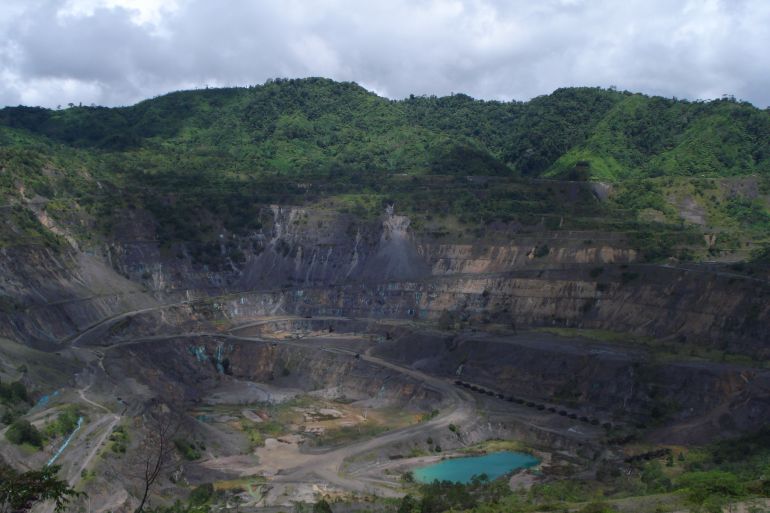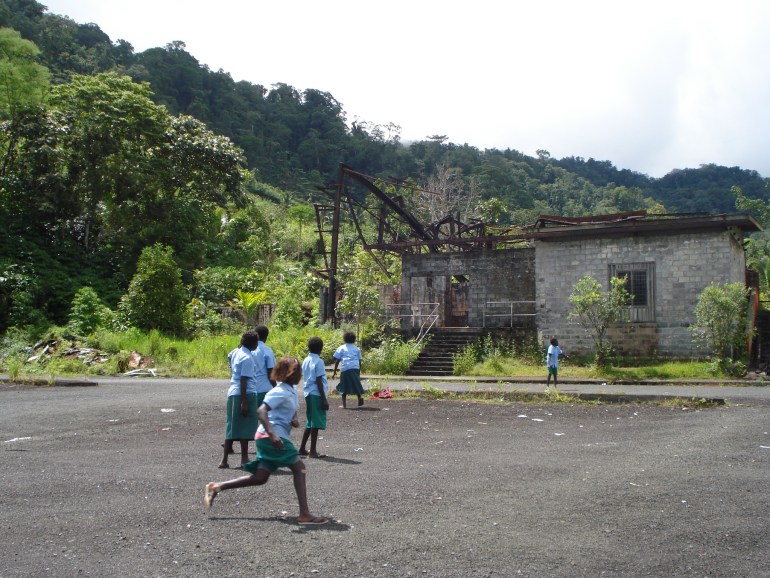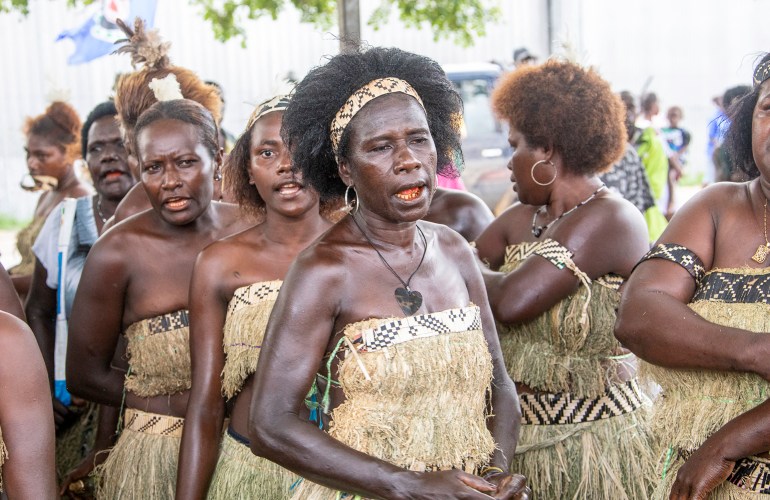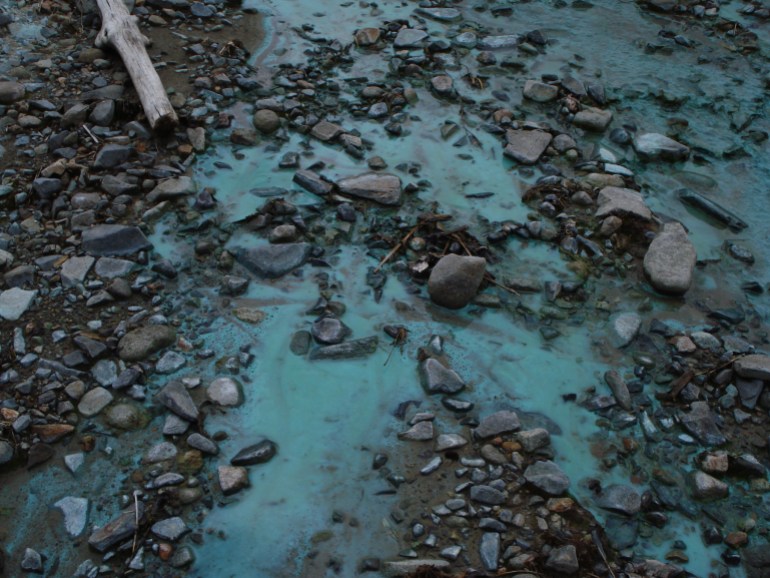Bougainville starts process to reopen controversial Panguna mine
Officials say the facility will provide crucial income despite triggering a war and poisoning the environment before it was forced to close.

The controversial Panguna mine, which lay derelict for more than 30 years following the eruption of a civil war on the remote islands of Bougainville – now an autonomous region of about 300,000 people in eastern Papua New Guinea (PNG) – is set to be revived to support the region’s plans for nationhood.
The Autonomous Bougainville Government has secured an agreement with local landowners to move ahead with plans to reopen the vast open-cut copper mine in the central mountains of Bougainville Island that was at the centre of a destructive decade-long conflict between Bougainville and PNG that ended in 2001.
Keep reading
list of 4 itemsFormer rebel leader elected Bougainville president
Bougainville: The world’s newest country?
Bougainville to vote on whether to become world’s newest country
“Today marks the ending and the beginning of a new chapter, a chapter to realise Bougainville’s independence,” Bougainville’s President Ishmael Toroama said in a public statement following the February deal with the chiefs of local landowning clans.
For nearly 20 years until 1989, Panguna was under the control of the global mining giant Rio Tinto and a source of anger for the local community who worried about its environmental effects and that most of the revenues went into the pockets of Rio Tinto and PNG.
“Overall, the resolution calls for transparent engagement of both parties in the process toward reopening the mine. For me, personally, as a landowner, I do support the development, but the development must be seen to be upholding and respecting the fundamental rights of humanity and our Indigenous rights,” Peter Arwin, a Panguna landowner, told Al Jazeera.
For years, there was significant opposition to the return of foreign extractive companies from communities that continue to live with the pollution caused by mine waste and who suffered brutality and trauma during the conflict. For a region struggling with post-war recovery, the massive cost of reconstructing the mine, estimated to be in the range of $5-6bn, could only be met by a foreign investor. Rio Tinto relinquished its interest in the mine in 2016 and no new partner has yet been chosen.

But they were swayed by the government’s argument that the revival of the mine, estimated to harbour up to 5.3 million tonnes of copper and 19.3 million ounces of gold, is imperative to bankrolling Bougainville’s dream of independence, which won overwhelming support in a referendum held three years ago.
Bougainville’s economy remains weak with its government still financially dependent on PNG and international aid donors. Meanwhile, its people continue to struggle. Bougainville has one hospital and 35 health centres of varying sizes for a population of 300,000 people, while the maternal mortality rate is estimated to be up to three times higher than in PNG, where it is already among the worst in the world with 230 deaths per 100,000 live births.
About 40 percent of the population is under the age of 15.
“The signing of understanding by the five clans, particularly the Panguna mine pit owners, is the way forward toward the Panguna mine reopening to sustain the political will,” Theresa Jaintong, chair of the Arawa, Siokatei and Loloho Landowners Association in Arawa, about 12 kilometres from Panguna, told Al Jazeera. “The signing of the agreement signifies oneness, peace and support for the government and the landowners coming to terms with the reopening of the mine.”
‘Anti-bad mining’
Arawa, the nearest town to the mine with a current population of more than 38,000, has been deeply affected by mining and the conflict. The town’s buildings, services and infrastructure were all razed during the civil war and reconstruction has been slow.
In PNG, more than 80 percent of land is owned by Indigenous clans who have a significant influence on public and commercially driven development projects. These rights were reinforced in Bougainville by new mining laws, which were introduced in 2015 and acknowledge Indigenous ownership of mineral resources located on customary land, and landowners’ participation in major decisions about their exploitation.
Core triggers of the conflict, which raged from 1989 until a ceasefire in 1998, included the exclusion of local landowners from mining-related decisions, resentment of foreign interference in Bougainville’s governance and economy since the late 19th century, the growing environmental fallout from the mine’s waste and the majority claim to its revenues by Rio Tinto and PNG.
Barbara Tanne, president of the Bougainville Women’s Federation, said it was crucial that a future mine contributed to peace, as well as prosperity in the region.
“As president of the Bougainville Women’s Federation, I’d like to say that may this agreement be honoured and be inclusive to all. Women need to maintain their status quo as landowners by continuing to reflect back [on the past], having peace dialogues with the landowning clans and ensuring peace and stability is rooted with them,” she emphasised.

Much needs to be done before the Panguna mine can be reopened.
Bougainville’s Minister for Mineral and Energy Resources, Rodney Osioco, is adamant that preparations for mining development in the region will be rigorous at every stage to ensure the islanders’ rights, equitable distribution of the mine’s benefits, and peace and stability are secured. The government plans to strengthen its laws and regulatory framework, while any future investor in the mine will be decided in consultation with landowners.
“Addressing the grievances and the issues that surrounds distribution of benefits should be number one and must be done in a more transparent approach [than in the past]. Then there is the issue of landownership that needs to be sorted out through proper social mapping processes as well,” Arwin told Al Jazeera.
Gavin Mudd, associate professor of environmental engineering at Australia’s Royal Melbourne Institute of Technology, believes that addressing the unresolved issues from the mine’s past, such as environmental damage and demands for compensation, are critical.
“The people of Bougainville have never been anti-mining, they are anti-bad mining, and there’s a long way to go until we get really close to addressing the historical legacy,” he said.
Toxic hazard
How to handle the environmental waste from the mine, which was never decommissioned, is a priority for villagers. Rivers near the mine, for instance, have been polluted with toxic heavy metals, such as copper, zinc and mercury, which have poisoned the waters, decimated fish populations and pose a significant risk to human health.
“Polluted water from the mine pit flows unabated into local rivers …The chemical contamination of the rivers is compounded by ongoing erosion from the vast mounds of tailings waste dumped by the company in the Jaba river valley. With each heavy rainfall, huge volumes of tailings sand are washed into the rivers, flooding large tracts of land downstream with polluted mud; displacing villages, contaminating water sources and destroying new areas of forest and agricultural land,” the Melbourne-based Human Rights Law Centre (HRLC), which has been assisting in the remediation process that began last year, reported in 2020.
In initial discussions with local communities and stakeholders in Bougainville, aided by the HRLC, Rio Tinto has agreed to an expert assessment of the mine’s environmental and human rights impacts.
In any future operations, there is no doubt that waste disposal methods will have to change. An important option, according to Mudd, is to build a tailings dam, a dam specifically constructed to store water and waste by-products of the mining process. “We are better at building tailings dams than we were 50 years ago, but it will take time. They are huge structures and they’re expensive,” he explained.

The price tag of rebuilding the mine from its present ruins is estimated to be in the range of $5-6bn. The time it will take is dependent on a lot of variables, but Mudd estimates that reconstruction “could take up to a decade or more”.
This time around, people on the islands are wiser about the realities, and potential pitfalls, of resource extraction, especially when land is so central to their culture.
“In our Melanesian society, to be landless means that I have no value in the community,” Arwin said, stressing the need for the government to ensure the community’s needs are properly met.
He is mindful of the difficult balancing act Bougainville is now attempting.
“I know that, at the end of the lifespan of mining, the place will become a barren wasteland all covered with rocks, while no more monetary benefits will be forthcoming,” he said. “But the fact is that our future generations will live on beyond.”